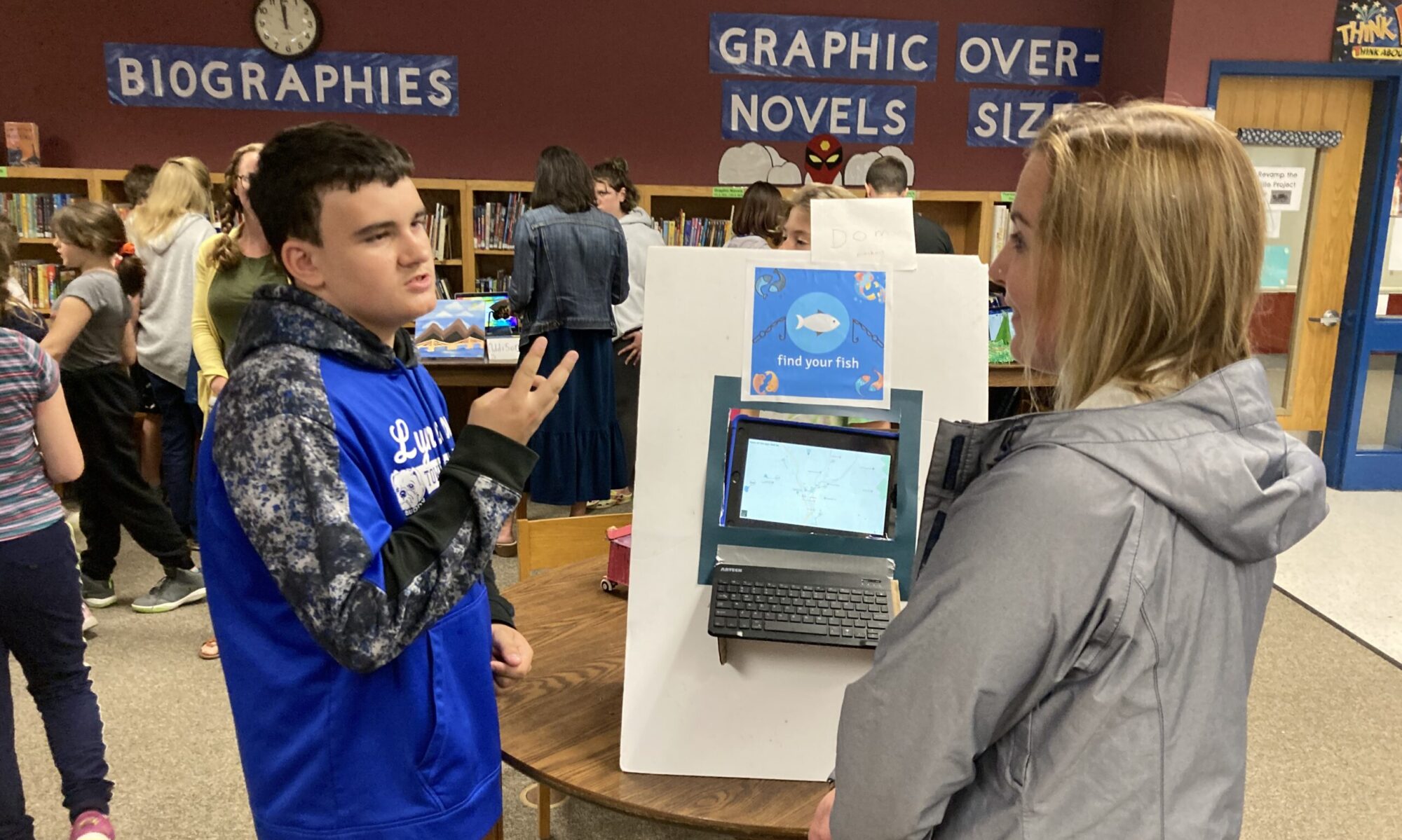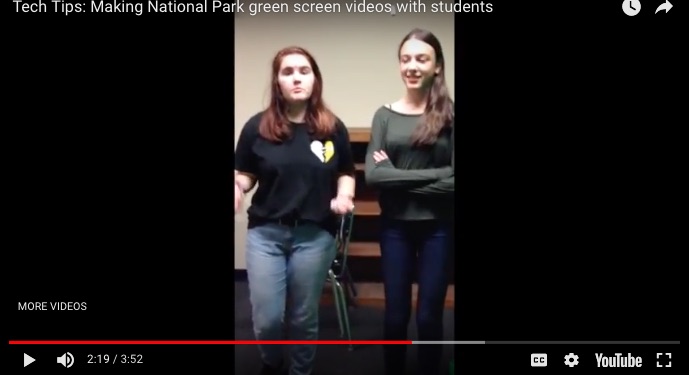Student-created virtual park tours
With access to online and tablet-based tools for digital curation and content creation, students can research the history, challenges and attractions of one of our nation’s 58 (!) National Parks. Under the rubric of planning a visit to them, students can answer an essential and timeless question: What features make National Parks special and worth saving?
It’s almost as good as being there. Especially if you’re trapped in snow and/or don’t have your driver’s license yet. Let’s roll!

But don’t take our word for it, check out how Lamoille Union Middle School educators Sydney Copp and Heidi Rich ran this assignment with their students.
[huge_it_slider id=”6″]
The Assignment
Research:
During Science class, you have surveyed National Parks of the United States and chosen a park to study in order to:
- Plan an argument in defense of Wilderness
- Find 5 images of different parks & quotes to go along with them
- Go in-depth about one National Park & Plan a trip to visit the park for a week!
Next, you need to find this additional information:
- The history of the park
- Who founded it? When? Why?
- Any environmental reasons the park is or could be in danger
- Human impact or natural forces
- Two things people can do to help protect the park!
Record any sources you use to do research
- Save websites to the home screen and organize in a folder called “National Parks Project”
- TAKE NOTES FROM YOUR RESOURCES!!!
- Using Notability, Google Docs or your paper notebook.
Presenting:
After researching the National Park you chose, decide on a way of presenting your information to others. In your presentation you must include:
- Your statement of belief regarding the value of Wilderness. This is purely an opinion piece. (You may, however, use specific information / facts to make your point.)
- Your itinerary*** for a week-long visit & any highlights / places not to miss if you visit! (including other National Parks nearby)
- ***3 highlights from your 10-day trip
- Information you find from your additional research:
- A list of some of the more interesting animals and plants that can be found in your wild place
- Any interesting geologic features etc
- Things that make your park unique and famous
- A list of what you’d want to pack for your trip to get the most enjoyment out of it. (Appropriate clothes for the type of climate, binoculars, camera to capture the scenery… etc.)
- Creative spin to make an engaging presentation!
The Assessment
Basic Project/Presentation Ideas–
- Poster
- Google Presentation (formerly PowerPoint)
- Pic Collage Poster
Next Level Project/Presentation Ideas–
Nearpod presentation
- iMovie trailer or short movie
- Green screen iMovie
- Using actual photographs of the park, you can film your iMovie “in the park”!
Technologies/Resources to utilize:
- 360cities.net
- National Parks Owner’s guide
- Library databases (Global issues in context, National Geographic)
But how does this magic actually work?
A full transcript appears below.
A female student stands in front of a green screen, looking off-screen at a camera:
Girl 1: Hey there. I’m currently in Glacier National Park. Glacier is located in Montana. The Blackfeet Reservation is the west border of the park. The Canadian border is the norther border of the park.
The scene changes: Susan Hennessey stands next to a male student as they both regard an iPad on a desk:
Susan: Tell me a little bit about the project.
Boy 1: So, this is the parks project, where we talk about how we each choose which park to do, and I chose Fall Creek Falls because it’s pretty and it has the largest waterfall east of the Mississippi. It’s a fun project.
Susan: Talk about the iPad please. How do you use the iPad to tell the story?
Boy 1: So, I have made a list of questions on the iPad. And then, I have gone through and recorded a clip for each of my questions. So I answered my questions with the clips on the green screen. It was fun.
Susan: So does that mean it’s gonna look like you’re at the park? Is that how the green screen works?
Boy 1: About as much as you can get it. It looks kinda cheesy because, (chuckles), because it’s pretty cheesy (chuckles).
Susan: Did you aim for cheese as the tone?
Boy 1: Yeah, that’s kinda who I am.
Susan: I love that; that’s perfect. Good. So, right now you’re cutting it together on there and then you’re going to show it to us after it’s ready.
Boy 1: Yeah.
Susan: Ok. Thanks, we’re done.
Boy 1: Thank you for having me.
The scene changes again: a different male student sits on a stool, addressing someone off-camera:
Boy 2: Welcome back! And, uh, in the Grand Canyon, there is 167 species of fungi, 64 species of moss (as you see behind me), and 195 species of lichen.
One final scene: the female student from the beginning reappears with her friend. They stand together in front of a green screen, addressing the camera. Susan Hennessey is off-camera, asking them questions.
Girl 1: So, this is a National Parks project for science and social studies combined.
Girl 2: Yeah, so what we have to do is we’re looking up a National Park in America. Some kids are doing some out of the country. But we’re studying the science and the history of the National Park, and then we’re making a project out of it.
Girl 1: And then we’re going to take our project and, instead of just doing a normal power point, or pic collage, or something, we’re supposed to make it into a video, or something more complicated, so that we can make it kind of…
Girl 2: Fun.
Girl 1: …different and unique with each one, instead of everyone doing the same project.
Girl 2: But we can still use like pic collage to help us with the project. And maybe like a powerpoint, kind of.
Girl 1: Yeah.
Susan: And you guys are using…?
Girls 1&2: We’re using green screen.
Girl 2: Because we’re doing kind of like an iMovie thing.
Girl 1: So, it kind of shows — it takes a green backdrop, and it puts an image over the green, and then you stand in front of it, and it puts you in the picture and videos you with the picture that you’ve chosen in the background.
Girl 2: But, like, there’s a complicated way to do it. You can’t put the background in first, and then the camera because then you’re like in the background.
Girl 1: That’s true.
Girl 2: So you have to do the camera first, and then the picture.
Girl 1: And then the picture.
Girl 2: *makes excited noise* Thank you! Thank you, thank you, thank you!



Studying National Parks with digital tools #vted https://t.co/aYRBGCJ5Z6
RT @innovativeEd: Studying National Parks with digital tools #vted https://t.co/aYRBGCJ5Z6
For the p.m. crowd: virtual National Park tours with iPad and green screen https://t.co/gjdjV6MYes @NPCA
Ready to go student project with options for assessment. Study National Parks with digital tools https://t.co/5wG30xtdpn #tec21lcms #880J
Study National Parks with digital tools https://t.co/tWIT6PeLwj @lauranylen @Mrskupiec Use the entire world for an EOY project…thoughts?
Study National Parks with digital tools https://t.co/0nkP5sB2rY via @innovativeEd
Study National Parks with digital tools, a rubric for middle school students to research and pr.. https://t.co/6mn7PrAl7q #Disrupt